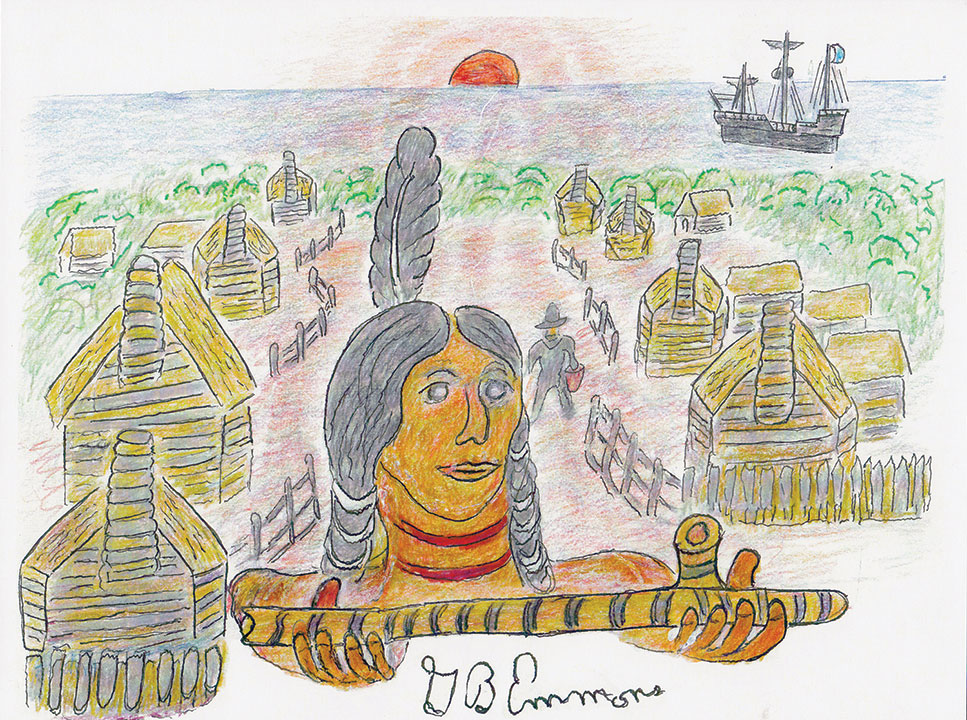Massasoit (1590-1661) was the grand sachem intertribal chief of all the Wampanoag Indians of the coastal regions of today’s Massachusetts and Rhode Island. His tribes included his own Pokanoket village of Bristol, the Sakonnet people of Rhode Island, Acushnet of New Bedford, Agawam of Mattapoisett, the Nausets of Cape Cod, and Aquinnah of the Vineyard and Nantucket. To other inland tribes, they were known as the eastern people of the rising Sun, as the first to see the light of day coming up over the horizon of the ocean.
Then the apparition of the Mayflower appeared, on wings of change that foreshadowed what would be many more colonists to come to Native American shores.
In March of 1621, several months after the landing of the Mayflower at Plymouth, Massasoit visited the new colony with an intention to ensure peaceful accord and trade between the races. He and Governor John Carver smoked a ceremonial peace pipe, as illustrated. His spoken promises were to be a treaty of peaceful accord, which lasted as long as he lived. Massasoit instructed his fellow Indians to share techniques of planting, hunting, fishing, harvesting, and cooking, as half of the Pilgrims that made the ocean journey had already died of malnutrition and exposure to the elements. Later in life, Massasoit was sent a solid silver smoking pipe from King James of England as thanks for saving his tenuous New World colony.
Equally vital for Pilgrim and Wampanoag security was Massasoit’s insistence on a mutual agreement to defend each other if attacked by the nearby Narragansett. When the Pilgrims decided to celebrate a bountiful harvest of Thanksgiving, Massasoit was invited and brought 90 warriors as guests. Giving native thanks for seasonal harvest was a frequent habit by the Wampanoag. They started in spring with a strawberry festival, and then the green corn ceremony in late July. The latter was followed by a fast, after which any wrongdoings might be forgiven for those willing to repent.
Harvest of corn itself had a metaphysical spirit of sustenance from the good earth. For the Thanksgiving feast, they pounded the dried ears into a dish they called nasaump, as well as a stewed pumpkin porridge called pompion. The first Thanksgiving lasted three days and was filled with Indian song, games, and dance punctuated and blessed by Pilgrim religious prayers, as well as marching of Myles Standish’s military soldiers.
Later in the winter of 1623 when Massasoit became deathly ill, colonial leader Edward Winslow traveled many miles with broth through the snow to nurse him back to health. Meanwhile, the Indian’s friend, Roger Williams, who preached that all the land still belonged to the Indians, was convicted of religious heresy by the Bay Colony in Boston and sentenced to extradition back to England. Williams escaped to Rhode Island and was invited by Massasoit to spend the winter in his lodge, and in spring, Massasoit sold Williams nearby land to found the Providence Plantation of religious freedom.
Now almost 400 years later, a new book about the Wampanoags is available in South Coast libraries, written by David Silverman and titled This Land is Their Land – the very preaching of Roger Williams.
And so, when we bow our heads at Thanksgiving, let us give thanks for the peace pipe welcome of Massasoit and the hospitality of the Wampanoag of Native America.
By George B. Emmons

He was so nice to the colonists and they wouldn’t have survived without him. Over the years they slowly took away his land. After his death his son was in power. He fought to get the land back. He is was defeated then assassinated. This is payment for trusting white people who just can’t be trusted.
Truer words have never been spoken.